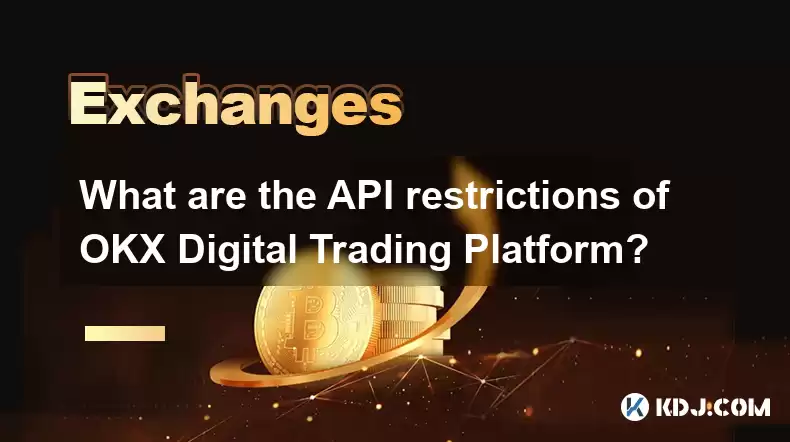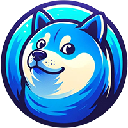-
 bitcoin
bitcoin $87959.907984 USD
1.34% -
 ethereum
ethereum $2920.497338 USD
3.04% -
 tether
tether $0.999775 USD
0.00% -
 xrp
xrp $2.237324 USD
8.12% -
 bnb
bnb $860.243768 USD
0.90% -
 solana
solana $138.089498 USD
5.43% -
 usd-coin
usd-coin $0.999807 USD
0.01% -
 tron
tron $0.272801 USD
-1.53% -
 dogecoin
dogecoin $0.150904 USD
2.96% -
 cardano
cardano $0.421635 USD
1.97% -
 hyperliquid
hyperliquid $32.152445 USD
2.23% -
 bitcoin-cash
bitcoin-cash $533.301069 USD
-1.94% -
 chainlink
chainlink $12.953417 USD
2.68% -
 unus-sed-leo
unus-sed-leo $9.535951 USD
0.73% -
 zcash
zcash $521.483386 USD
-2.87%
What are the API restrictions of OKX Digital Trading Platform?
OKX's API restrictions, encompassing rate limits, data access, and usage policies, are crucial for platform stability and security; non-compliance may lead to account suspension or permanent bans.
Mar 07, 2025 at 10:24 am

What are the API Restrictions of OKX Digital Trading Platform?
Key Points:- OKX's API restrictions are designed to maintain platform stability, security, and prevent abuse. These restrictions cover rate limits, data access, usage permissions, and acceptable practices.
- Understanding these restrictions is crucial for developers building trading bots or integrating OKX into their applications. Failure to adhere to these rules can lead to account suspension or permanent ban.
- OKX provides comprehensive documentation outlining API limitations, but this article aims to provide a more detailed and nuanced understanding of these restrictions.
- Specific limitations vary across different API endpoints and functionalities, requiring careful consideration of individual needs.
- Rate Limiting: OKX implements rate limits to prevent overload and ensure fair access for all users. These limits restrict the number of API requests a user can make within a specific timeframe. The limits are dynamic and may vary based on several factors including the specific endpoint being accessed, the user's API key's assigned tier (if applicable), the current server load, and the overall platform activity. Exceeding these limits will result in temporary throttling, meaning your requests will be temporarily delayed or rejected. Repeated or severe violations might lead to more significant penalties, such as temporary or permanent suspension of your API key. Understanding the rate limits for each endpoint is paramount. OKX's documentation typically provides request limits in requests per second (RPS) or requests per minute (RPM). However, it's crucial to monitor your API usage closely and adjust your application's request frequency accordingly to avoid exceeding these limits. Implementing exponential backoff strategies, where the delay between requests increases after failed attempts, is a common practice to handle rate limiting gracefully. Proper error handling within your application is vital to identify and respond appropriately to rate limit responses from the OKX API. This may involve pausing execution, retrying requests after a suitable delay, or notifying the user about the limitation. Ignoring rate limits can lead to your API key being temporarily or permanently disabled.
- Data Access Restrictions: OKX's API does not provide access to all platform data. Certain information is considered proprietary or sensitive and is therefore unavailable through the API. This might include internal operational data, user-specific data beyond what is necessary for trading, and certain financial metrics related to the platform's overall performance. The scope of data access is deliberately limited to protect user privacy and maintain the integrity of the platform's operations. Accessing restricted data through unauthorized means, such as attempting to bypass security measures or exploiting vulnerabilities, will result in immediate account action, including potential legal consequences. Developers must carefully review the API documentation to understand precisely what data is available and what is not. Building applications that rely on accessing restricted data is highly discouraged and may lead to serious repercussions. Furthermore, even with access to permitted data, it is crucial to handle this information responsibly and securely. Implementing proper data encryption, secure storage, and access control measures is essential to protect user data and comply with data privacy regulations.
- Authentication and Permissions: OKX utilizes robust authentication mechanisms to secure API access. This typically involves API keys and potentially secret keys that must be kept confidential. These keys grant specific permissions, limiting what actions a user can perform via the API. For instance, a read-only API key will only allow access to data retrieval functionalities, while a full trading key allows for executing trades, managing orders, and withdrawing funds. The level of access granted is determined during the API key creation process and can be modified later, but this requires careful consideration. Compromising your API keys, either through negligence or malicious attacks, can lead to unauthorized access to your account and potential financial losses. Therefore, storing API keys securely is critical. Avoid hardcoding keys directly into your applications; instead, use environment variables or secure configuration management tools. Regularly review and rotate your API keys to mitigate risks. Implementing multi-factor authentication (MFA) wherever possible adds an extra layer of security. Unauthorized use of an API key, even if resulting from negligence, can result in account suspension and potential financial losses.
- Acceptable Usage Policy: OKX maintains a clear acceptable usage policy (AUP) that outlines prohibited activities related to API usage. This policy typically covers activities such as: market manipulation, automated trading strategies that violate fair trading practices, using the API for illegal activities, exceeding rate limits persistently, and distributing or sharing API keys inappropriately. Violating the AUP can lead to immediate and permanent suspension of API access and potentially legal action. Developers must carefully review and understand the AUP before using the OKX API. Building applications that engage in any prohibited activity is strictly forbidden. Understanding and adhering to the AUP is crucial to maintaining a fair and secure trading environment for all users. Any attempts to circumvent the AUP's restrictions will be met with severe consequences. Continuous monitoring of your API usage and the application's behavior is vital to ensure compliance with the AUP. Regularly reviewing OKX's updated AUP is recommended to stay informed about any changes or additions.
A: Exceeding OKX's API rate limits will initially result in temporary throttling, where your requests are delayed or rejected. Repeated or severe violations can lead to temporary or permanent suspension of your API key.
Q: Can I access all OKX platform data through the API?A: No, OKX restricts access to certain data for security and privacy reasons. Only specific data relevant to trading and account management is typically available through the API.
Q: How secure are OKX's API authentication methods?A: OKX employs robust authentication mechanisms, including API keys and potentially secret keys, to secure API access. However, it is the user's responsibility to safeguard these keys and follow secure coding practices.
Q: What are the consequences of violating OKX's API acceptable usage policy?A: Violating OKX's API acceptable usage policy can lead to immediate and permanent suspension of API access, and potentially legal action.
Q: Where can I find detailed documentation on OKX's API restrictions?A: Detailed documentation on OKX's API restrictions, including rate limits and acceptable usage policies, is typically available on the official OKX developer website. It's crucial to regularly check for updates to this documentation.
Q: How often should I rotate my API keys?A: There's no single definitive answer, but it's best practice to rotate your API keys regularly, at least every few months, or more frequently if there's any suspicion of compromise.
Q: What should I do if I suspect my API key has been compromised?A: If you suspect your API key has been compromised, immediately revoke the key through the OKX platform and generate a new one. Also, investigate the potential breach and take appropriate security measures to prevent future incidents.
Q: Can I use the OKX API to build a high-frequency trading (HFT) bot?A: While you can use the OKX API for algorithmic trading, it's crucial to ensure your strategies comply with OKX's AUP and do not violate fair trading practices or lead to market manipulation. OKX may have specific restrictions on HFT strategies.
Q: What kind of support does OKX offer for API developers?A: OKX typically offers developer support through documentation, forums, or potentially direct support channels for registered developers. Refer to their developer portal for specifics.
Q: Are there different levels of API access available?A: Yes, OKX likely offers different levels of API access, granting varying permissions based on the type of API key generated (e.g., read-only vs. full trading access). Refer to their documentation for the specific tiers available.
Q: What types of errors might I encounter when using the OKX API?A: You might encounter errors related to rate limiting, authentication failures, invalid requests, insufficient permissions, or server-side issues. Proper error handling is crucial in your application.
Q: How can I monitor my API usage and ensure I'm not exceeding rate limits?A: OKX may provide tools or dashboards to monitor your API usage. Alternatively, you can implement logging and monitoring within your application to track requests and identify potential rate limit issues. Consider using third-party API monitoring tools.
Disclaimer:info@kdj.com
The information provided is not trading advice. kdj.com does not assume any responsibility for any investments made based on the information provided in this article. Cryptocurrencies are highly volatile and it is highly recommended that you invest with caution after thorough research!
If you believe that the content used on this website infringes your copyright, please contact us immediately (info@kdj.com) and we will delete it promptly.
- Hyperliquid's HYPE Tokens: Team Vesting Kicks In As DeFi Powerhouse Continues Its Ascent
- 2025-12-29 06:30:02
- DASH Bullish Rally Ignites: Analysts Set Price Targets Amidst Shifting Market Sentiment
- 2025-12-29 07:10:01
- Binance Charts New Course in Syria as Sanctions Lifted, Unlocking Crypto Access
- 2025-12-29 07:15:01
- Trust Wallet Tussle: Navigating Hacks, Compensation, and Cryptocurrency Platform Issues
- 2025-12-29 07:05:01
- PNC Bank, Coinbase & Crypto: Wall Street Takes a Bitcoin Bite (But Check the Fine Print)
- 2025-12-29 07:15:01
- FedWatch Shows Market Shift: Investors Brace for Potential Rate Cuts Amid Shifting Economic Signals
- 2025-12-29 07:00:02
Related knowledge

How to find your Bybit deposit address?
Dec 26,2025 at 02:39pm
Accessing Your Bybit Deposit Interface1. Log in to your Bybit account using your registered credentials or biometric authentication if enabled. 2. Nav...

A full review of the Bybit NFT Marketplace.
Dec 28,2025 at 08:20pm
Platform Overview1. Bybit NFT Marketplace launched in early 2022 as a dedicated digital asset trading venue integrated directly into the Bybit ecosyst...

What are the benefits of being a VIP on Bybit?
Dec 27,2025 at 11:40am
VIP Tier Structure and Eligibility1. Bybit assigns VIP status based on a user’s 30-day average net asset value, calculated from the sum of assets held...

How to trade altcoins on the Bybit spot market?
Dec 25,2025 at 05:39am
Accessing the Bybit Spot Market Interface1. Log in to your Bybit account using verified credentials and two-factor authentication. 2. Navigate to the ...

Bybit "Order submission failed" error: How to fix it?
Dec 26,2025 at 08:20pm
Troubleshooting the Order Submission Failed Error1. The error message “Order submission failed” on Bybit commonly appears when a user attempts to plac...

What are perpetual contracts on Bybit? An easy explanation.
Dec 27,2025 at 11:39pm
What Are Perpetual Contracts?1. Perpetual contracts are derivative instruments that track the price of an underlying asset—such as Bitcoin or Ethereum...

How to find your Bybit deposit address?
Dec 26,2025 at 02:39pm
Accessing Your Bybit Deposit Interface1. Log in to your Bybit account using your registered credentials or biometric authentication if enabled. 2. Nav...

A full review of the Bybit NFT Marketplace.
Dec 28,2025 at 08:20pm
Platform Overview1. Bybit NFT Marketplace launched in early 2022 as a dedicated digital asset trading venue integrated directly into the Bybit ecosyst...

What are the benefits of being a VIP on Bybit?
Dec 27,2025 at 11:40am
VIP Tier Structure and Eligibility1. Bybit assigns VIP status based on a user’s 30-day average net asset value, calculated from the sum of assets held...

How to trade altcoins on the Bybit spot market?
Dec 25,2025 at 05:39am
Accessing the Bybit Spot Market Interface1. Log in to your Bybit account using verified credentials and two-factor authentication. 2. Navigate to the ...

Bybit "Order submission failed" error: How to fix it?
Dec 26,2025 at 08:20pm
Troubleshooting the Order Submission Failed Error1. The error message “Order submission failed” on Bybit commonly appears when a user attempts to plac...

What are perpetual contracts on Bybit? An easy explanation.
Dec 27,2025 at 11:39pm
What Are Perpetual Contracts?1. Perpetual contracts are derivative instruments that track the price of an underlying asset—such as Bitcoin or Ethereum...
See all articles










































































